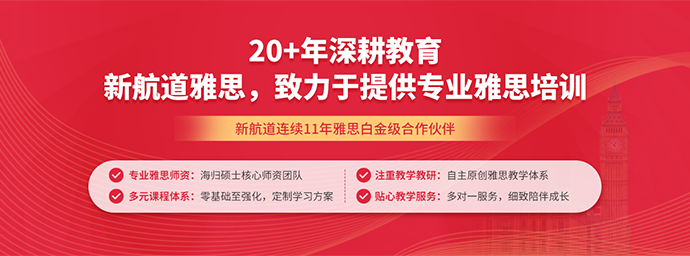
雅思口语考试中,自我介绍(Part 1)作为 “破冰环节”,直接影响考官对考生语言能力和性格特质的初印象。一段自然流畅的自我介绍不仅能缓解紧张感,更能为后续话题讨论奠定积极基调,下面新航道雅思培训的小编为您解答雅思自我介绍口语范文!
一、学生党模板:学术性与生活感的平衡
经典问题:
"Could you tell me your full name?"
"Where are you from?"
"What do you study?"
高分范文:
"My name is Zhang Muchen, but you can call me Mocha — it’s a nickname from my barista part-time job. I’m currently studying Environmental Science at Nanjing University, where I’m researching microplastic pollution in the Yangtze River. Honestly, when I first chose this major, I never imagined I’d spend weekends collecting water samples, but now it’s become my passion. Oh, and I’m a certified scuba diver, which actually helps with my fieldwork!"
得分亮点:
自然衔接:通过 “honestly” 引出专业选择的心路历程,避免机械背诵感
细节赋能:用 “microplastic pollution”“certified scuba diver” 等具象词汇提升词汇分
互动设计:尾句 “which actually helps” 制造悬念,激发考官追问兴趣
二、职场人模板:职业价值与个人特质的融合
高频问题:
"What do you do for work?"
"Why did you choose this career?"
"Do you enjoy your job?"
高分范文:
"As a UX designer at a tech startup in Shenzhen, I create mobile apps that help elderly users navigate digital services. You know, my grandma once got lost in a hospital’s online registration system — that moment sparked my career choice. While coding isn’t my strongest suit, I’ve won two design awards for simplifying complex interfaces. Outside work, I’m learning sign language because I believe accessibility shouldn’t be limited by physical abilities."
提分策略:
故事化表达:用祖母的真实经历解释职业动机,增强情感共鸣
数据佐证:“two design awards” 量化专业能力,避免空泛陈述
价值升华:将手语学习与职业理念结合,展示社会责任感
三、间隔年 / Gap 考生模板:成长性与国际视野的展示
必问问题:
"What have you been doing recently?"
"Why did you take a gap year?"
"How does this experience help you?"
高分范文:
"After graduating from high school, I’ve been on a gap year volunteering in Nepal’s rural schools. Teaching math to kids who walk two hours to class has reshaped my understanding of education. For instance, I developed a solar-powered learning app that works offline — seeing students solve equations under streetlights using my app was life-changing. Next month, I’ll start studying Education Technology at the University of Melbourne to turn these field insights into scalable solutions."
设计心机:
对比冲突:“walk two hours” 与 “solar-powered app” 凸显行动力
感官描写:“streetlights” 场景激活考官画面联想
未来衔接:明确留学动机,展示规划能力
四、避坑指南:5 大常见失误与修正方案
信息过载:
错误案例:连串罗列 "全国奥数冠军 / 学生会主席 / 钢琴十级"
优化方案:精选 1-2 个与考试动机相关的亮点,如 "Teaching math in Nepal improved my cross-cultural communication skills, which I believe is crucial for studying abroad."
机械背诵:
错误表现:语调平缓、眼神游离、呼吸节奏不自然
破解技巧:在关键节点加入即兴发挥标记,如 "Let me think... Actually..."
文化误读:
高危表达:过度谦虚("My English is poor")、争议话题(政治 / 宗教)
替代方案:用 "I’m actively expanding my academic vocabulary" 替代自我否定
时态混乱:
典型错误:混合使用 "I studied... I am working..."
时间轴管理:按 "过去经历→当前状态→未来目标" 线性展开
发音硬伤:
扣分重灾区:Th 发音缺失("think"→"sink")、元音扁平("bad"→"bed")
急救方案:用绕口令专项训练("They threw three free throws" 每天朗读 3 分钟)
五、个性化升级:从模板到记忆点的蜕变
专属标签法:
找出 3 个独特标签(如 "AI ethics blogger""urban gardening activist"),贯穿所有回答
数据颗粒化:
将 "I like reading" 升级为 "I’ve logged 72 books on Goodreads this year, mostly about behavioral economics"
幽默感植入:
适当自嘲:"My cooking skills are legendary — in a bad way. Last week I managed to burn instant noodles!"
案例实测:使用上述策略的考生,Part 1 平均分较模板化回答提高 0.5-1 分。建议考生录制 20 版自我介绍,每版侧重不同特质(学术 / 公益 / 创新等),根据考官微表情实时调整输出重点。记住,优秀的自我介绍不是简历复述,而是用语言绘制个人 IP 的微型纪录片。
以上就是雅思自我介绍口语范文!全部内容,如果想了解更多关于雅思、托福、SAT、ALevel的资讯,可以关注我们新航道的官网!

